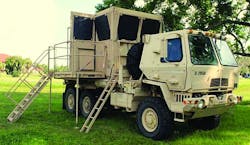Army orders five mobile air traffic control towers from Sierra Nevada for deployed operations
REDSTONE ARSENAL, Ala., 5 Nov. 2014. U.S. Army aviation experts are asking for five mobile air traffic control towers from manufacturer Sierra Nevada Corp. in Sparks, Nev., to help coordinate air traffic in battlefield and other temporary airfields.
Officials of the Army Contracting command at Redstone Arsenal, Ala., announced a $15.2 million contract to Sierra Nevada on Monday for five airfield Mobile Tower Systems (MOTS).
The Army Sierra Nevada AN/MSQ-135 rapid-deployment MOTS helps Army field commanders to establish air traffic control operations quickly worldwide for all-weather conditions, night or day, for military and civilian aircraft.
The MOTS is a stand-alone air traffic control system with secure and jam-resistant radio communications. The modular system includes controller shelter, portable 36-kilowatt power generator trailer, airfield lighting system, and meteorological sensors.
Army commanders can transport and deploy MOTS from armored vehicles within theater, or can be airlifted by C-17 aircraft or CH-47 helicopter.
MOTS can communicate with other air traffic control and battle command systems, meets FAA/ICAO regulations, and is suitable for disaster relief efforts, forest fire mobile operations, and temporary tower operations.
On this contract Sierra Nevada will do the work in Sparks, Nev., and should be finished by September 2016. For more information contact Sierra Nevada Corp. online at www.sncorp.com, or the Army Contracting Command at Redstone Arsenal at www.acc.army.mil/contractingcenters/acc-rsa.

